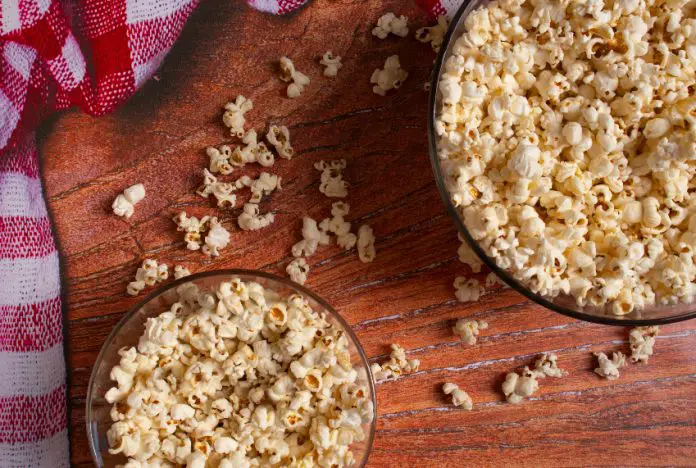“Momochtli,” the Nahuatl word for popcorn (called “palomitas de maíz” in Spanish), has been consumed in Mexico for centuries. Archaeologists estimate that popcorn may have been consumed in Mesoamerica more than 6,000 years ago. Corn cultivation in the region dates to the beginning of agriculture – 9,000 years ago.
Fifty-nine different strains of corn are native to Mexico, but only seven are used to make popcorn: Chapalote, Palomero Tolugueno, Nal Tel, Exploder, Palomero from Chihuahua, Palomero from Jalisco and Puebla Palomero, a sub-breed from the Central Transvolcanic Knot.
The Spanish encounter popcorn being made by the Aztec
The Spanish first encountered popcorn when they invaded Mexico.Spanish chronicler Friar Bernardino de Sahagún first detailed the discovery in “General History of Things in Mexico”. The Aztecs would throw the corn kernels directly into the fire or on a hot griddle (“comal”) until they popped, bursting into the shape of a flower.
According to Sahagún, popcorn was also used in religious celebrations and festivals, with garlands of popcorn used as ornamentation for altars and statues. He witnessed women wearing wreaths of toasted corn on their heads instead of flowers as they danced the “popcorn dance” at a festival in honor of Tezcatlipoca, God of the night. He also described the festivals of Opochtli, a deity of fishermen, where the Mexica used popcorn in their ceremonies, writing that it was “a type of corn that when roasted bursts and reveals the kernel and becomes a very white flower, they [the Mexica] said that these were hailstones, which are attributed to the water gods.” In some regions, popcorn was said to represent stars.
The Maya myth of Dziú
According to Maya myth, Dziú – a bird with multi-colored feathers with chestnut brown eyes – was just a normal bird when Yuum Chaac, the god of water and agriculture noticed that a drought was causing the land to lose its fertility. Alarmed, he called all the birds together proclaiming an emergency. He would have to burn the crops so that the ash would fertilize the soil. The god of fire, Kak would start the blaze, but they would need to collect all the varieties of seeds to replant the crops. Dziú arrived early and diligently collected more seeds than any other bird, finally resting in the shade, with Yuum Chaac’s permission.
The next morning Yuum Chaac realized the fire was endangering the place the workers had readied for sowing new crops. Yuum Chaac sent out another emergency call to the birds for help. When Dziú arrived, he observed the situation from a tree branch – watching with amazement as the corn kernels popped into white flowers – and threw himself into the fire to save as many corn kernels as he could. When he finished, exhausted, his eyes had turned red and his feathers were burned.
To honor this act of bravery, the other birds promised always to protect the descendants of the Dziú. Yuum Chaac honored Dziú by decreeing that his descendants would always have red eyes and wingtips the color of ash to remind the other birds of their promise.
Today, his descendants are the birds now known as the red-eyed thrush.
The Great Depression popularized popcorn in the United States
Popcorn became forever linked with movie theaters in the United States during the Great Depression (1923 – 1933) as a cheap snack to munch on while watching silent cinema, which gave them temporary respite from their sorrows. Bags of popcorn were sold from popcorn carts outside the door at first but when theater owners realized how much money the vendors were earning, they installed their own popcorn machines inside the theater. The addition of butter and salt made it a very popular and enduring snack for moviegoers.
For those who forego salt and butter, lime, chili, cheese, and caramel can be added. Popcorn can also be prepared using olive and avocado oils for added flavor and nutrition.
Popcorn is a very nutritional treat
According to the Cleveland Clinic, natural popcorn (with no salt or butter) is very healthy. It contains a high level of antioxidants – even higher than some fruits and vegetables – and contributes to better circulation and reduction of certain diseases like cancer.
Popcorn is loaded with fiber, which is critical to the proper functioning of the digestive system and can reduce the possibility of contracting heart disease or diabetes. Additionally, popcorn is rich in vitamins and minerals such as B-complex, Iron, Magnesium, Phosphorus, Potassium, Zinc, and Copper.

Caramel corn is also said to come from Mexico
Caramel corn may also have originated in Mexico. Centuries ago, some Mexican communities roasted popcorn kernels on a comal and then sweetened it with maguey honey, creating a sweet treat.
In Chiapas, “puxinú” is still prepared from popcorn mixed with local piloncillo honey which is then shaped into squares. This beloved snack can still be found in markets, sweet stands, or being sold out of baskets by vendors walking through neighborhoods, especially during the festival of San Sebastian on January 20. Puxinú is most popular in Chiapas – especially in Tuxtla Gutierrez and Chiapa de Corzo.
The most beautiful ear of corn is the Gema de Cristal grown in Tehuacán and has kernels that shine like precious gems.
Sheryl Losser is a former public relations executive, researcher, writer, and editor. She has been writing professionally for 35 years. She moved to Mazatlán in 2021 and works part-time doing freelance research and writing. She can be reached at AuthorSherylLosser@gmail.
